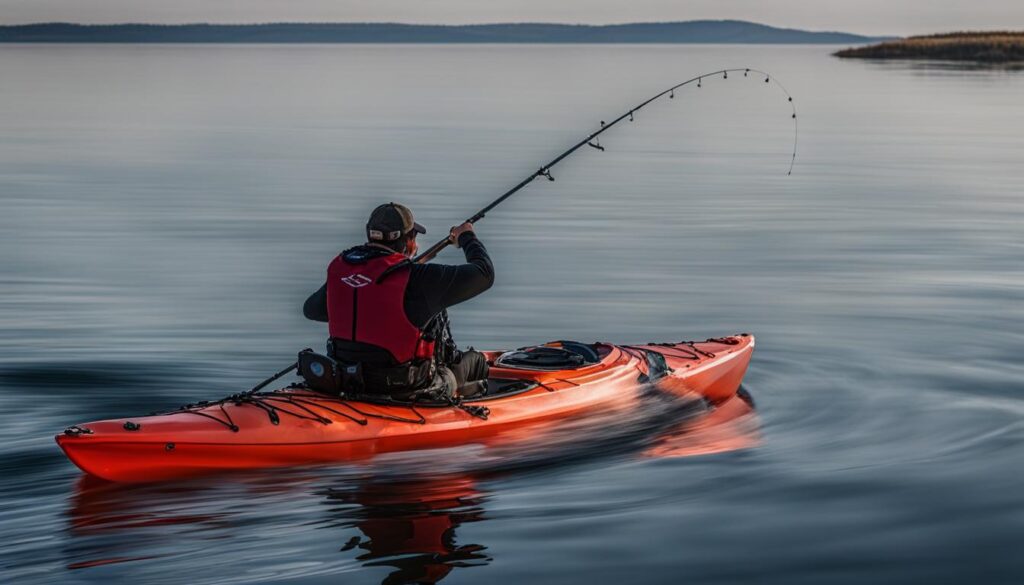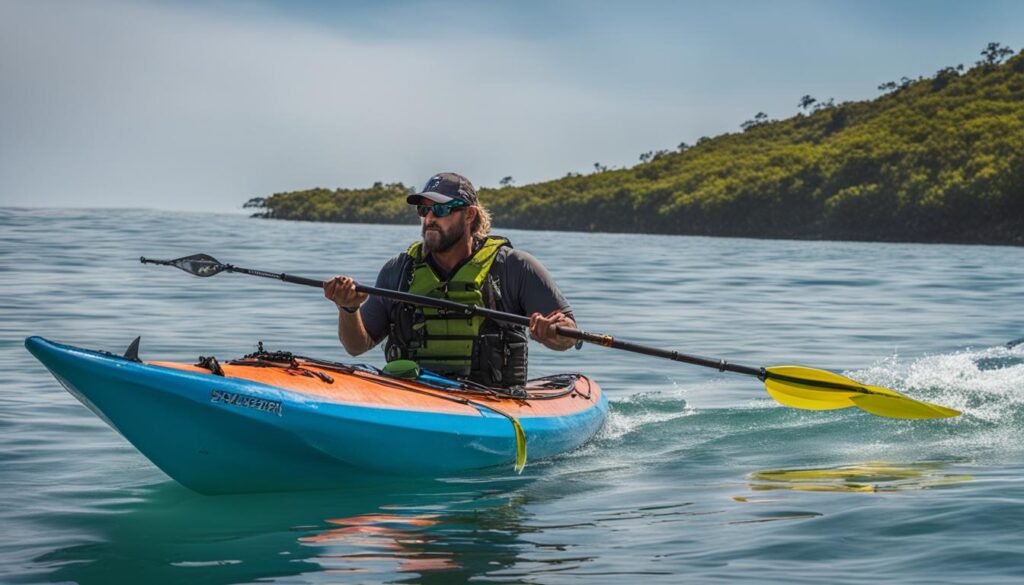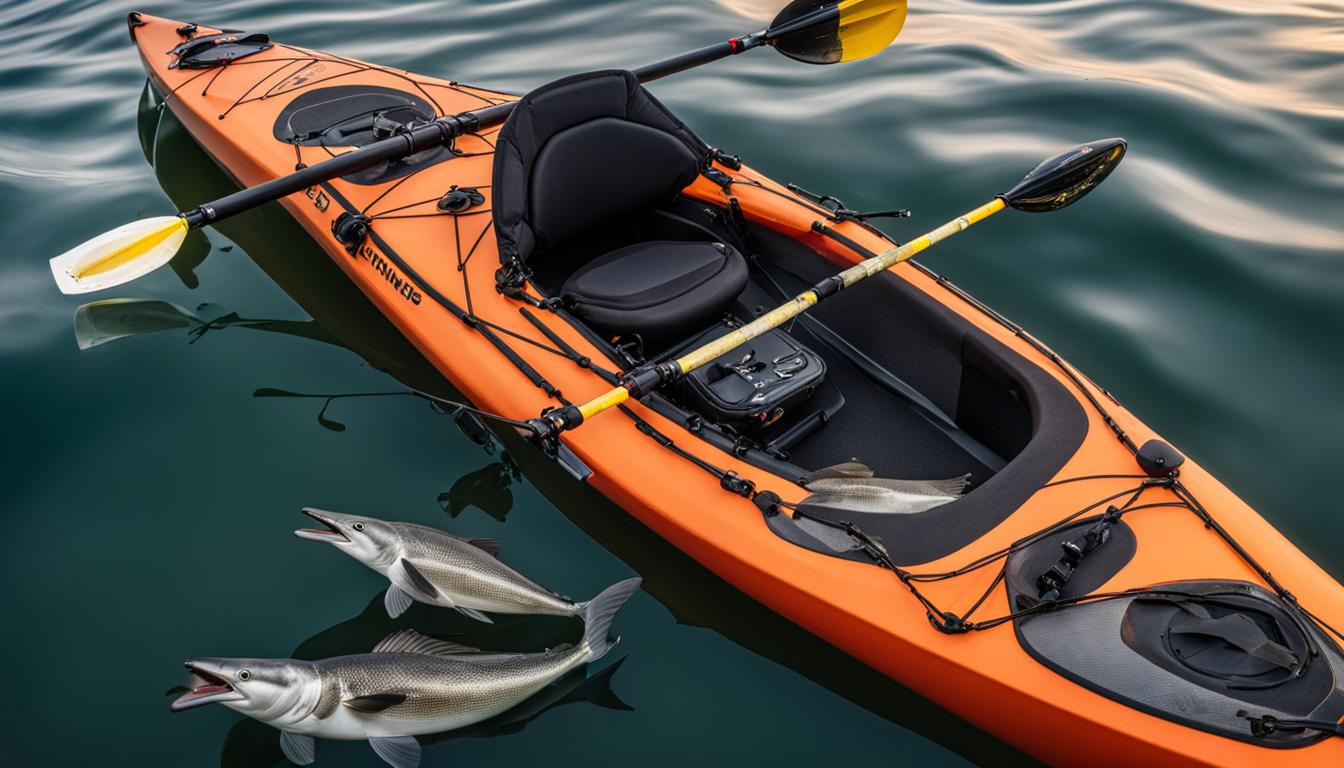Trolling is an effective method for covering a large area of water and maximizing fishing time. It allows you to keep your lure in the water while paddling for miles, increasing your chances of finding fish. Trolling from a kayak requires proper rigging to ensure success. In this section, we will explore the essential techniques and tips for rigging your kayak for effective trolling.
Key Takeaways:
- Properly rigging your kayak is essential for successful trolling.
- Trolling allows you to cover more water and increase your chances of finding fish.
- Using a high-powered fish finder and GPS can greatly improve your trolling success.
- Fine-tuning your kayak trolling setup can enhance your overall fishing experience.
- Each fish species may require specific trolling techniques and tips.
Trolling Techniques for Kayak Fishing
Trolling from a kayak offers a wide range of benefits for anglers, making it an essential skill to learn for any kayak fishing enthusiast. By optimizing your kayak for trolling, you can significantly enhance your chances of success on the water. Here, we’ll explore the essentials of kayak trolling and provide valuable tips and techniques to help you master this fishing method.
Trolling allows you to cover more water compared to traditional casting and retrieve methods. This means you can explore a larger area, increasing the likelihood of finding fish. By keeping your lure in the water while paddling, you maximize your fishing time and keep your bait in the strike zone for longer periods. This technique is particularly effective for species that are highly migratory or dwell in open waters.
“Trolling from a kayak provides the opportunity to effectively target a variety of fish species, including salmon, trout, walleye, and striped bass,”
Optimizing your kayak for trolling involves several key considerations. Firstly, you need to ensure your kayak is stable and properly balanced to handle the additional drag caused by trolling. This can be achieved by using a kayak with a wide and stable hull design, or by adding stabilizing accessories such as outriggers or pontoons.
Additionally, it’s important to equip your kayak with the necessary gear for successful trolling. This includes rod holders positioned strategically to maximize line spread and prevent tangles. Using a fish finder and GPS can also greatly enhance your trolling experience as they allow you to locate structures, underwater contours, and potential feeding zones.
Essentials of Kayak Trolling
When it comes to trolling from a kayak, there are a few essential techniques to keep in mind. Firstly, maintaining a consistent trolling speed is important to ensure the proper action of your lure. This can be achieved by paddling at a steady pace or by utilizing a trolling motor if permitted in your fishing area.
Experimenting with lure depth and presentation is also crucial to optimize your trolling setup. Different fish species occupy various depths in the water column, so adjusting your presentation to match their preferred depth can significantly increase your chances of attracting bites.
| Fish Species | Optimal Trolling Depth | Recommended Lure |
|---|---|---|
| Salmon | 15-25 feet | Flasher rig with hoochie or spoon |
| Trout | 5-10 feet | Inline spinners or small crankbaits |
| Walleye | 10-20 feet | Jigging minnow or worm harness |
| Striped Bass | 10-30 feet | Large swimbaits or live bait |
By understanding the optimal trolling depths for different fish species and utilizing the appropriate lures, you can maximize your chances of enticing strikes and landing trophy fish.

Mastering the art of kayak trolling opens up a world of fishing opportunities. Whether you’re chasing salmon, trout, walleye, or striped bass, the techniques and tips provided here will help you optimize your kayak for trolling and increase your chances of a successful fishing expedition.
Trolling from a Kayak: Tips and Strategies for Success
When it comes to trolling from a kayak, implementing the right techniques and strategies can significantly improve your chances of finding fish. In this section, we will explore valuable tips that will help you master the art of kayak trolling and enhance your fishing experience.
Use a High-Powered Fish Finder and GPS
Investing in a high-powered fish finder and GPS system is crucial for successful kayak trolling. These tools will enable you to locate fish and identify underwater structures, increasing your chances of finding productive fishing spots. By marking potential hotspots on your GPS, you can easily navigate back to them in the future, ensuring you never miss out on a promising location.
Pay Close Attention to the Rod Tip
One of the keys to successful kayak trolling is closely monitoring the movement of your rod tip. A subtle twitch or bend can indicate a strike, and being attentive allows you to react quickly and capitalize on the opportunity. Keep your eyes fixed on the rod tip and be prepared to set the hook at any moment.
Master Boat Handling Skills
Proper boat handling skills are essential for effective kayak trolling. Making wide turns helps prevent yourself from spooking fish, as sudden movements can scare them away. Additionally, staggering the distance and depth of your lures creates a more natural presentation, increasing the likelihood of enticing strikes. Practice these maneuvers to improve your overall trolling success.
| Trolling Tips for Success | Benefits |
|---|---|
| Invest in a high-powered fish finder and GPS system | Locate fish and identify underwater structures |
| Pay close attention to the rod tip | React quickly to strikes |
| Master boat handling skills | Prevent spooking fish and create a natural presentation |
By implementing these strategies and tips, you can improve your chances of finding fish while trolling from a kayak. Remember to equip yourself with the right tools, pay attention to your surroundings, and practice boat handling skills. With time and experience, you’ll become a master at trolling from a kayak and enjoy successful fishing expeditions on the water.
Kayak Fishing Trolling Setups: Fine-Tune Your Kayak Trolling Setup
When it comes to trolling from a kayak, having the right setup can make a significant difference in your fishing success. Fine-tuning your kayak trolling rig ensures that you’re equipped with the necessary tools and configurations to maximize your chances of landing that prized catch.
Choosing the Right Fishing Line
Selecting the appropriate fishing line is crucial for kayak trolling. Using a thin mainline, such as monofilament or braided line, allows for better lure action and cuts through the water with less resistance. A lighter line also reduces drag, enabling your lure to dive deeper and imitate natural movement. Combine your mainline with a heavier, clear leader to prevent fish from detecting your line and increase your chances of enticing strikes.
Optimizing Rod Holder Placement
Properly positioning your rod holders is vital to avoid tangles and ensure easy access to your rods while trolling. By angling your rod holders outward, you can spread out your lines and prevent them from crossing over each other. Consider using track-mounted rod holders placed ahead of your seat, providing convenient access and visibility of the rod tip while pedaling. This setup allows you to keep a close eye on your rods and quickly respond to any bites or changes in lure action.
Utilizing a Fish Finder
A fish finder can significantly enhance your kayak trolling experience by helping you locate fish and underwater structures. By identifying potential hotspots on your fish finder’s GPS, you can mark them as waypoints and return to them on future trips. Utilize the sonar capabilities of your fish finder to identify fish arches and depth changes, allowing you to adjust your trolling speed and lure depth accordingly. A fish finder can provide you with valuable real-time information to fine-tune your trolling approach and maximize your chances of success.
| Mainline | Leader | Rod Holder Placement | Fish Finder | |
|---|---|---|---|---|
| Advantages | Thin line for better lure action | Heavier, clear leader to prevent detection | Outward angle for easy access and prevention of tangles | Locate fish and underwater structures |
| Tips | Consider monofilament or braided line | Use clear leader with higher pound test than mainline | Utilize track-mounted rod holders | Learn to interpret fish arches and depth changes |
Trolling Tips for Specific Fish Species
Trolling from a kayak opens up exciting opportunities to target specific fish species. By understanding the unique characteristics and behavior of each species, you can tailor your trolling techniques to increase your chances of success. In this section, we will explore valuable tips and tactics for trolling from a kayak for three popular fish species: king mackerel, brown and rainbow trout, and striped bass.
Trolling for King Mackerel from a Kayak
King mackerel are known for their powerful runs and aggressive strikes. When trolling for king mackerel from a kayak, use live bait such as cigar minnows or threadfin herring. Deploy multiple lines at varying depths to increase your chances of enticing these fast-moving predators. A wire leader is essential to prevent bite-offs, as king mackerel have sharp teeth. Keep your trolling speed around 5-7 knots to mimic the natural movement of baitfish.
Trolling for Brown and Rainbow Trout from a Kayak
Trolling for trout from a kayak allows you to cover vast stretches of water, increasing your chances of locating these elusive fish. Use small spoons, spinners, or plugs in natural colors to imitate the prey that trout feed on, such as minnows or small insects. Adjust your trolling speed to match the trout’s preferred feeding speed, usually around 1-2 knots. Pay attention to water temperature and depth, as trout often prefer cooler, deeper waters during the summer months.
Trolling for Striped Bass from a Kayak
Striped bass are renowned for their strong fighting ability, making them a thrilling target for kayak anglers. When trolling for striped bass, use large swimbaits, plugs, or soft plastics in colors that mimic the local forage. Experiment with different depths and speeds to find the most productive combination. Striped bass are often found near structure such as rocks or submerged ledges, so be sure to troll along these areas. Keep an eye out for diving birds, as they can indicate the presence of feeding stripers.
| Fish Species | Bait/Lure | Trolling Speed | Trolling Depth | Tips |
|---|---|---|---|---|
| King Mackerel | Live bait (cigar minnows, threadfin herring) | 5-7 knots | Varied depths | Use wire leaders to prevent bite-offs |
| Brown and Rainbow Trout | Small spoons, spinners, or plugs | 1-2 knots | Varied depths | Match lure colors to natural prey |
| Striped Bass | Large swimbaits, plugs, or soft plastics | Varied speeds | Varied depths | Troll near structure and look for diving birds |
Remember, these tips are just a starting point, and experimenting with different techniques and adjustments is key to finding what works best for your specific fishing location and conditions. Always stay informed about local fishing regulations and ensure you have the appropriate licenses before targeting specific fish species. Happy trolling!

Conclusion
Trolling from a kayak can be a highly effective method for catching fish. By properly rigging your kayak and utilizing the right techniques and tips, you can enhance your trolling experience and increase your chances of success on the water. Whether you are a beginner or an experienced angler, mastering the art of kayak trolling can greatly improve your fishing expeditions.
Remember to fine-tune your setup, experiment with speed and depth, and stay safe on the water. With these insights and strategies, you’ll be well-equipped to become a successful kayak angler.
FAQ
What is trolling and why is it effective for kayak fishing?
Trolling is a method of fishing where you keep your lure in the water while paddling or pedaling your kayak. It allows you to cover a larger area of water and maximize your fishing time. By trolling, you increase your chances of finding fish and improving your fishing success.
What are some key factors to consider while trolling from a kayak?
To improve your chances of finding fish while trolling from a kayak, it’s important to use a high-powered fish finder and GPS to identify fish and structure. Marking potential spots on the GPS and paying close attention to the rod tip are essential. Boat handling skills, such as making wide turns and staggering the distance and depth of the lures, are also critical.
How should I rig my kayak for trolling?
A properly rigged setup is essential for successful kayak trolling. Using thin mainline to cut through the water and a heavier, clear leader can improve your chances of fooling fish. Angle your rod holders to spread out the lines and prevent tangles. Track-mounted rod holders placed ahead of the seat can provide easy access and visibility of the rod tip while pedaling.
Are there specific trolling techniques for different fish species?
Yes, trolling techniques may vary depending on the targeted fish species. For example, when trolling for king mackerel from a kayak, using live bait or brightly colored lures can be effective. Trolling for brown and rainbow trout may require varying lure depths and speeds. Trolling for striped bass often involves using umbrella rigs or large swimbaits. Each species has its own preferred techniques and tactics.
Why should I learn how to troll from a kayak?
Learning how to troll from a kayak can greatly enhance your fishing experience. It allows you to cover more water, increase your chances of finding fish, and improve your overall fishing success. Whether you are a beginner or an experienced angler, mastering kayak trolling can greatly enhance your fishing expeditions.





